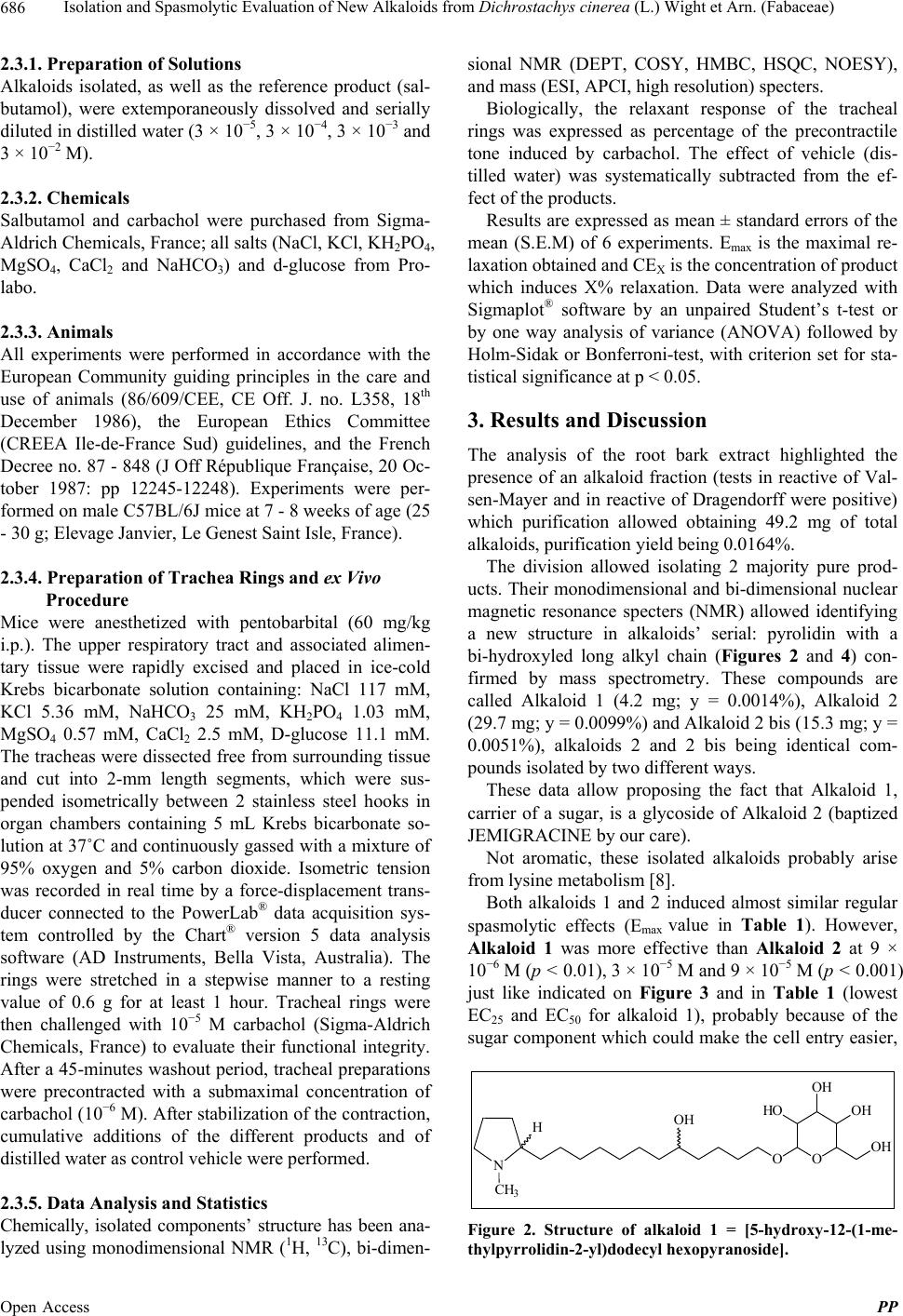
Isolation and Spasmolytic Evaluation of New Alkaloids from Dichrostachys cinerea (L.) Wight et Arn. (Fabaceae)
686
2.3.1. Preparation of Solutions
Alkaloids isolated, as well as the reference product (sal-
butamol), were extemporaneously dissolved and serially
diluted in distilled water (3 × 10−5, 3 × 10−4, 3 × 10−3 and
3 × 10−2 M).
2.3.2. Chemicals
Salbutamol and carbachol were purchased from Sigma-
Aldrich Chemicals, France; all salts (NaCl, KCl, KH2PO4,
MgSO4, CaCl2 and NaHCO3) and d-glucose from Pro-
labo.
2.3.3. Animals
All experiments were performed in accordance with the
European Community guiding principles in the care and
use of animals (86/609/CEE, CE Off. J. no. L358, 18th
December 1986), the European Ethics Committee
(CREEA Ile-de-France Sud) guidelines, and the French
Decree no. 87 - 848 (J Off République Française, 20 Oc-
tober 1987: pp 12245-12248). Experiments were per-
formed on male C57BL/6J mice at 7 - 8 weeks of age (25
- 30 g; Elevage Janvier, Le Genest Saint Isle, France).
2.3.4. Preparation of Trachea Rings and ex Vivo
Procedure
Mice were anesthetized with pentobarbital (60 mg/kg
i.p.). The upper respiratory tract and associated alimen-
tary tissue were rapidly excised and placed in ice-cold
Krebs bicarbonate solution containing: NaCl 117 mM,
KCl 5.36 mM, NaHCO3 25 mM, KH2PO4 1.03 mM,
MgSO4 0.57 mM, CaCl2 2.5 mM, D-glucose 11.1 mM.
The tracheas were dissected free from surrounding tissue
and cut into 2-mm length segments, which were sus-
pended isometrically between 2 stainless steel hooks in
organ chambers containing 5 mL Krebs bicarbonate so-
lution at 37˚C and continuously gassed with a mixture of
95% oxygen and 5% carbon dioxide. Isometric tension
was recorded in real time by a force-displacement trans-
ducer connected to the PowerLab® data acquisition sys-
tem controlled by the Chart® version 5 data analysis
software (AD Instruments, Bella Vista, Australia). The
rings were stretched in a stepwise manner to a resting
value of 0.6 g for at least 1 hour. Tracheal rings were
then challenged with 10−5 M carbachol (Sigma-Aldrich
Chemicals, France) to evaluate their functional integrity.
After a 45-minutes washout period, tracheal preparations
were precontracted with a submaximal concentration of
carbachol (10−6 M). After stabilization of the contraction,
cumulative additions of the different products and of
distilled water as control vehicle were performed.
2.3.5. Data Analysis and Statistics
Chemically, isolated components’ structure has been ana-
lyzed using monodimensional NMR (1H, 13C), bi-dimen-
sional NMR (DEPT, COSY, HMBC, HSQC, NOESY),
and mass (ESI, APCI, high resolution) specters.
Biologically, the relaxant response of the tracheal
rings was expressed as percentage of the precontractile
tone induced by carbachol. The effect of vehicle (dis-
tilled water) was systematically subtracted from the ef-
fect of the products.
Results are expressed as mean ± standard errors of the
mean (S.E.M) of 6 experiments. Emax is the maximal re-
laxation obtained and CEX is the concentration of product
which induces X% relaxation. Data were analyzed with
Sigmaplot® software by an unpaired Student’s t-test or
by one way analysis of variance (ANOVA) followed by
Holm-Sidak or Bonferroni-test, with criterion set for sta-
tistical significance at p < 0.05.
3. Results and Discussion
The analysis of the root bark extract highlighted the
presence of an alkaloid fraction (tests in reactive of Val-
sen-Mayer and in reactive of Dragendorff were positive)
which purification allowed obtaining 49.2 mg of total
alkaloids, purification yield being 0.0164%.
The division allowed isolating 2 majority pure prod-
ucts. Their monodimensional and bi-dimensional nuclear
magnetic resonance specters (NMR) allowed identifying
a new structure in alkaloids’ serial: pyrolidin with a
bi-hydroxyled long alkyl chain (Figures 2 and 4) con-
firmed by mass spectrometry. These compounds are
called Alkaloid 1 (4.2 mg; y = 0.0014%), Alkaloid 2
(29.7 mg; y = 0.0099%) and Alkaloid 2 bis (15.3 mg; y =
0.0051%), alkaloids 2 and 2 bis being identical com-
pounds isolated by two different ways.
These data allow proposing the fact that Alkaloid 1,
carrier of a sugar, is a glycoside of Alkaloid 2 (baptized
JEMIGRACINE by our care).
Not aromatic, these isolated alkaloids probably arise
from lysine metabolism [8].
Both alkaloids 1 and 2 induced almost similar regular
spasmolytic effects (Emax value in Table 1). However,
Alkaloid 1 was more effective than Alkaloid 2 at 9 ×
10−6 M (p ˂ 0.01), 3 × 10−5 M and 9 × 10−5 M (p ˂ 0.001)
just like indicated on Figure 3 and in Table 1 (lowest
EC25 and EC50 for alkaloid 1), probably because of the
sugar component which could make the cell entry easier,
NO
CH3
OOH
OH
OH
HO
OH
H
Figure 2. Structure of alkaloid 1 = [5-hydroxy-12-(1-me-
thylpyrrolidin-2-yl)dodecyl hexopyranoside].
Open Access PP